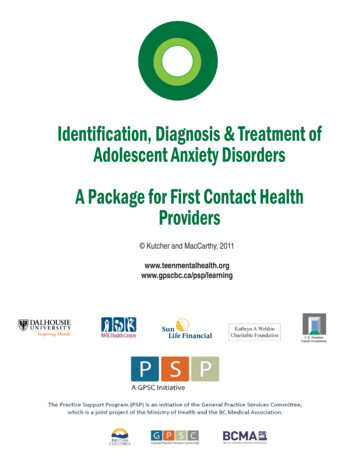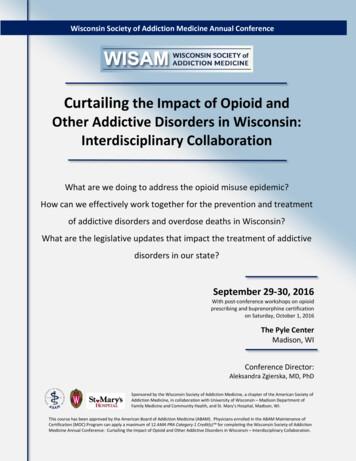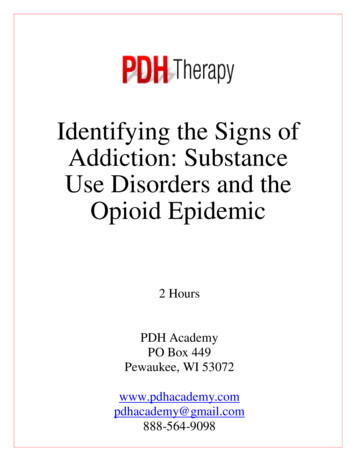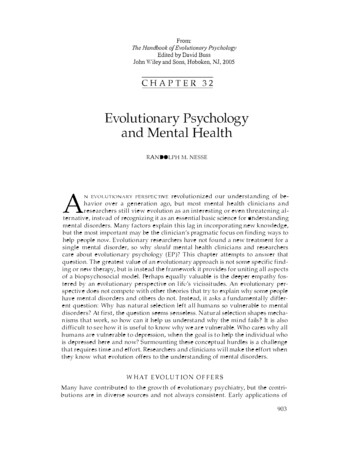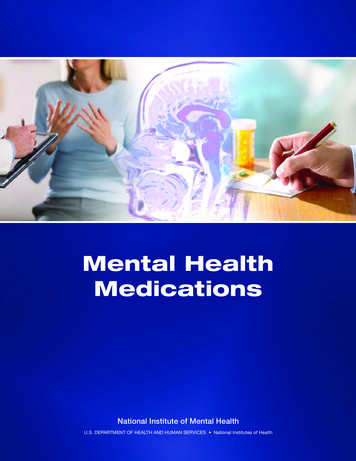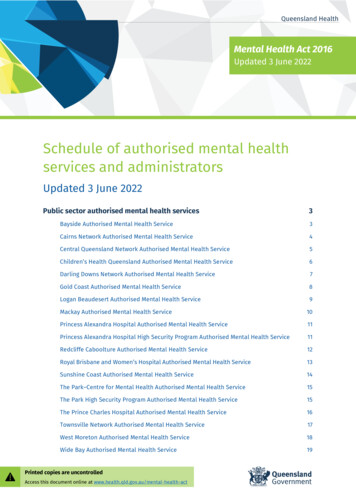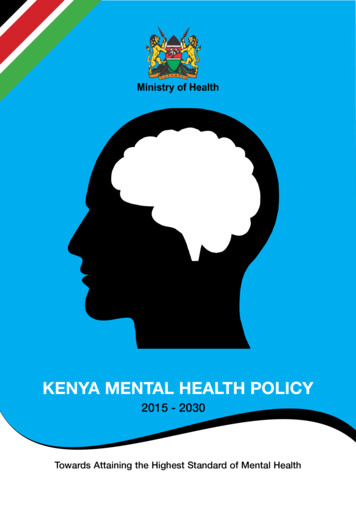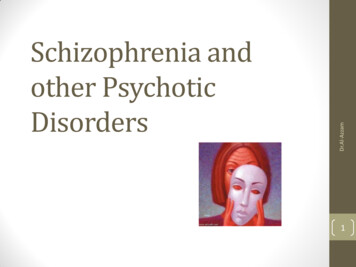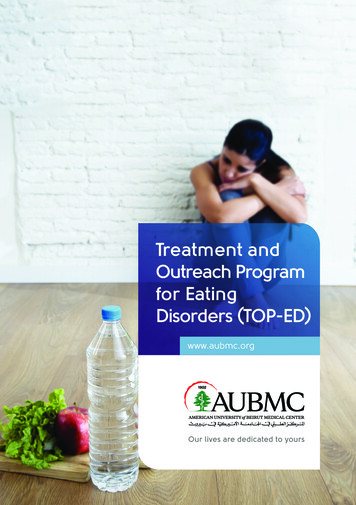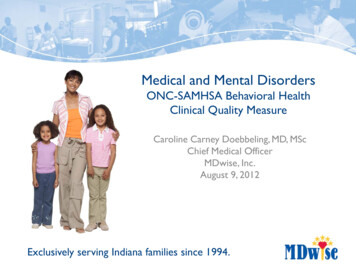
Transcription
Medical and Mental DisordersONC-SAMHSA Behavioral HealthClinical Quality MeasureCaroline Carney Doebbeling, MD, MScChief Medical OfficerMDwise, Inc.August 9, 2012Exclusively serving Indiana families since 1994.
Introduction MDwise is Indiana’s largest not-for-profit health planexclusively serving Medicaid populations Managed Care and Care Management programs 300,000 members throughout Indiana Delivery system model
Overview What is comorbidity?Why does it happen?Why is it important?What can we do?
Case History 28 y/o seen in ED for extreme agitation, complaining that heneeded treatment for ADD, and complained of hearing voices Seven ED visits and two inpatient mental health stays in 2012year to date Admitted to inpatient psychiatry unit Treated with two antipsychotics, one mood stabilizer, onebenzodiazepine, and two antidepressants Diagnoses over time included: schizophrenia, schizoaffectivedisorder, bipolar disorder, borderline personality disorder,PTSD, ADHD, substance abuse Developed GERD, pancreatitis, type II DM
The rest of the story At day seven of inpatient stay, unit called to request coverageof further days of stay On review– No standardized assessments– Increases in medications, with potential for significant drug:druginteraction– Emergency department labs ignored Final Diagnosis– Urine drug screen was positive at admission for PCP– All prior hospitalizations associated with positive drug screenson admit No links to primary care, except through ED care
How is Comorbidity Defined? Comorbidity – the co-occurrence of mental and physicaldisorders in the same person, regardless of the chronologicalorder in which they occurred or the causal pathway linkingthemRWJ Synthesis Project: Mental Disorders and Medical Comorbidity, B. Druss & E. Walker, Feb.2011
Scope of ProblemNational Comorbidity Survey Replication, 2001–200368% of adults with mentaldisordershave medical conditions29% of adults with medicalconditionshave mental disorders
Alcohol, Substances, and Primary Care Alcohol-related disorders occur in up to 26% of generalmedical clinic patients--prevalence rate similar to those forsuch other chronic diseases as hypertension and diabetes 6.1% of the population age 12 and older, currently use illicitdrugs 15.8% had engaged in binge or heavy drinking 5 million users of illicit drugs and 18 million people withalcohol use problems need treatment, but only one fourth ofthem receive it
Why?Katon WJ. “Clinical and Health Services Relationships between Major Depression,Depressive Symptoms, and General Medical Illness.” Biological Psychiatry, vol. 54, no. 3, 2003.
Why?Stress Exposure to stressors is linked to a weakening of the immunesystem and an increase in the inflammatory response Mental disorders, such as depression, are also linked toaltering the immune function and increasing inflammation The inflammatory response is usually a good thing to fightinfection or injury BUT, too much inflammation over too long a time leads toillness
% of Persons with Depression by PovertyStatus: 2005-2006NCHS Data Brief Sept 2008
% Persons who had Contact with Mental HealthProfessional by Depression SeverityMental Health Professional defined as psychologist, psychiatrist,psychiatric nurse, or clinical social workerCetan Health Consultants,LLC
Why?Adverse Behaviors Persons with mental illness are more likely to smoke– 44% of all cigarettes in the U.S. are consumed by persons with mentaldisorders– Persons with mental conditions are 2-3X as likely to smoke Persons treated for schizophrenia and bipolar disorder are 12X &20X more likely to be treated for alcohol abuse Persons treated for schizophrenia & bipolar disorder are 35X and42X more likely to be dependent on illegal drugs Up to 43 percent of civilians with PTSD & up to 75 percent ofveterans with PTSD have a substance abuse disorder People with severe mental illness (SMI) report less physical activity People with SMI have diets high in fat, low in protein, fresh foods– Access and economic issues
Medical Comorbidity with SMI?Carney, Jones: Psychosomatic Medicine & JGIM
What Is the Population Burden? 34 million American adults, or 17 percent of the adult population Which is more people than living in. . .2001–2003 National Comorbidity Survey Replication
The entire state of TexasUS Bureau of Statistics, 2011 populationdata for Texas 25,674,681
What Does Comorbidity Practically Mean? The odds of severe disability among those with both mentaldisorder and physical conditions were significantly greater than thesum of the odds of the single conditions Loss of role functioning– Education– Employment– ParentingPsychol Med. 2009 Jan;39(1):33-43. Epub 2008 Mar 26.
Alcohol Use in Primary Care
Opana Abuse in USA OvertakesOxycontin: USA TodayA masked man walked into a Fort Wayne, Ind., drugstore early one Saturday morning,approached the pharmacy counter and,realizing it was closed, left.An hour later, wearing the same mask, he entered the store across the street, handed thepharmacist a list of drugs scrawled ona napkin and threatened to kill the pharmacist if he didn't get them, police say.
PMPM Costs for Adult Medicaid Enrolled MembersWith and Without SMI—CY2009
Mortality Due to Mental Illness Persons receiving public assistance 1997-2001Nine states reportingSMR’s ranged from 1.2 (VA) to 4.9 (TX)Average years of life lost: 25-32 yrs.Average age of death: 49-60 y/oComparable to US Mortality in 1930’s2002 Nat’l Conference on Mental Health Statistics
Factors Contributions to Illness and Mortality
Models of Successful Integration Care Management/PCP Embedded in CommunityMental Health– Navigation Barriers– Expertise and trust with SMI– Focus on common conditions, preventive care Behavioral Care Embedded or Closely Coordinatedwith Medical Setting or Medical Homes Four Quadrant Model to Identify those with need Performance measures around what matters
MDwise and Integrated Care 68 RIDs Examined after 2 Statistically Extreme Outliers were RemovedAll Visit Types are IncludedPharmacy is Excluded
Quality of Preventive ServicesAll differences p 0.001Druss, et al. Am J Psych, 2010
Barriers Lack of qualified and/or willing providers Lack of integrated medical records between behavioral healthand medical providers Lack of funding for start-up costs Lack of incentive in FFS models Lack of payment structures to compensate comprehensivecare, or provider medical care in traditional mental healthsettings, or mental health care in medical settings
American Board of Internal Medicine: ResidencyRequirements The 36 calendar months of full-time internal medicineresidency education: Must include at least 30 months of training in general internalmedicine, subspecialty internal medicine and emergencymedicine. Up to four months of the 30 months may includetraining in areas related to primary care, such as neurology,dermatology, office gynecology or office orthopedics. May include up to three months of other electives approvedby the internal medicine program director. Includes up to three months of leave for vacation ss/im.aspx; accessed August 2012
Psychiatry Requirements A minimum of four-months in a primary care clinical settingthat provides comprehensive and continuous patient care inspecialties such as internal medicine, family medicine, and/orpediatrics. Neurology rotations may not be used to fulfill thisfour-month requirement. One month of this requirement maybe fulfilled by either an emergency medicine or intensive carerotation, provided the experience is predominantly withmedical evaluation and treatment and not surgical procedures,and No more than eight months in s/RRC progReq/400 psychiatry 07012007 u04122008.pdf; accessed August 2012
Family Medicine Requirements Human Behavior and Mental Health– should acquire knowledge and skills in this area through aprogram in which behavioral science and psychiatry areintegrated with all disciplines throughout the residents’ totaleducational experience. Training should be accomplished primarily in an outpatientsetting through a combination of longitudinal experiences anddidactic sessions.
Family Medicine Requirements There must be instruction and development of skillsin the diagnosis and management of psychiatricdisorders in children and adults, emotional aspectsof non-psychiatric disorders, psychopharmacology,alcoholism and other substance abuse, thephysician/patient relationship, patient interviewingskills, and counseling skills. This should includevideotaping of resident/patient encounters or directfaculty observation for assessment of eachresident’s competency in interpersonal C progReq/120pr07012007.pdf
Encounter Claims and theAttempt to Measure Quality Limited delivery of encounter claims by planBehavioral Health services carve outs 5% estimated behavioral healthSporadic pharmacy claimsInstituted claims capture P4PPhysical health/pharmacy 90%Mental health 75%
What Do We Do? Continuity and Coordination of Care– Range from 5-53% of audited charts had evidence of at least oneexchange of information HIPPA Clarifications Data capture through EMRS—links between physical andbehavioral health Training and work force issues Standardized Assessments: GAD, PHQ, MAST, CAGE Review of psychopharmacological treatment in primary care;ED Review of narcotic pain medications Payment practices Models of care
medicine, subspecialty internal medicine and emergency medicine. Up to four months of the 30 months may include training in areas related to primary care, such as neurology, dermatology, office gynecology or office orthopedics. May include up to three months of other electives approved by the internal medicine program director.

